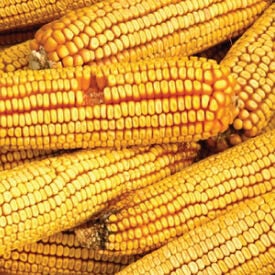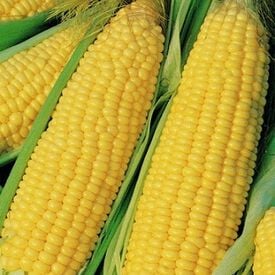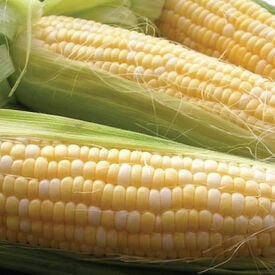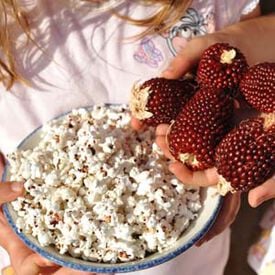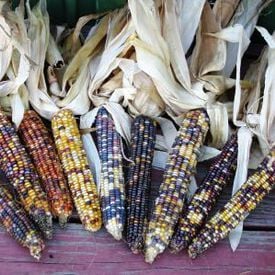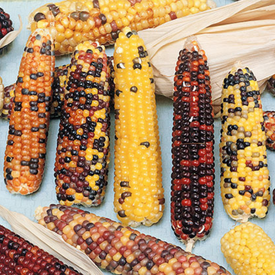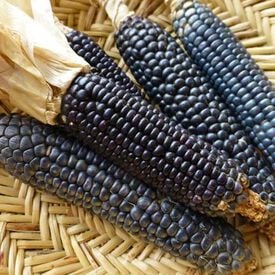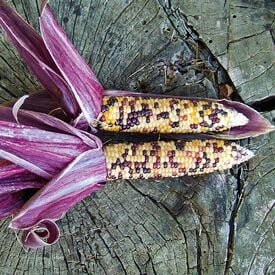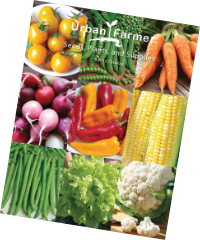Blue Cónico corn is a beautiful heirloom variety from Mexico, known for its striking blue-purple kernels and conical-shaped ears. This traditional corn is not only visually stunning but also prized for its rich, nutty flavor and excellent texture, which makes it ideal for grinding into masa to create tortillas, tamales, and other staple dishes. The plant is hardy and adaptable, thriving in a variety of climates, especially in higher altitudes, and is well-suited to organic and sustainable farming practices. Blue "Azul" Cónico corn is highly valued for its role in Mexican cuisine, where it adds both flavor and color to a wide range of dishes. As an open-pollinated variety, it is a favorite among farmers and gardeners who value biodiversity and the preservation of heritage crops, ensuring this ancient corn continues to be a significant part of Mexico's agricultural and culinary traditions.
Reid's Yellow Dent Field corn is a traditional American heirloom variety known for its high yield, excellent versatility, and resilience. Originally developed in the 19th century, this corn was once a staple in Midwestern farming due to its ability to thrive in a range of soil types and climates. The kernels are large, golden-yellow, and dented, which is characteristic of field corn varieties. Reid’s Yellow Dent is primarily grown for its use in animal feed, as well as for grinding into cornmeal, flour, and masa for making tortillas, cornbread, and other baked goods. It's also popular for producing hominy and grits, and historically, it played a significant role in the production of corn syrup and ethanol. What makes Reid's Yellow Dent particularly valuable is its resilience in the field, with a high tolerance for drought and disease. This heirloom variety is open-pollinated, making it an excellent choice for sustainable farming and seed-saving. It has a robust history in agricultural development and remains a beloved variety for both small-scale and commercial farmers looking to grow an adaptable, productive crop with a deep connection to agricultural traditions.
Truckers Favorite Yellow is an heirloom yellow dent field corn that is excellent for roasting or frying or used as a dent. This variety stays fresh for a long time. Truckers Favorite Yellow stalks are 8-9' tall and ears are 8-10" and have 14-18 rows. This corn has high yields with good soil fertilization and is an excellent foliage for early fodder.
Red Cónico corn is a striking heirloom variety from Mexico, known for its deep red kernels and distinctive conical shape. This traditional corn is prized for its rich, nutty flavor and excellent texture, making it ideal for grinding into masa for tortillas, tamales, or for use in savory dishes like soups and stews. The plant is hardy, thriving in a range of climates, particularly in high-altitude regions, and is often grown in smaller, family-owned farms where it has been cultivated for generations. Red "Rojo" Cónico corn’s deep cultural significance in Mexican cuisine, along with its vibrant color and versatility, make it a favorite for both home gardeners and farmers looking to preserve traditional varieties. Its open-pollinated nature also makes it a great choice for sustainable farming and seed saving.
Cherokee White Eagle corn is a traditional heirloom variety cherished for its striking appearance and cultural significance. This variety features tall plants that produce long ears adorned with white, plump kernels, which can sometimes have a slight yellow or cream tint. Known for its excellent flavor, Cherokee White Eagle corn is often used in a variety of culinary applications, including grits, cornmeal, and even as fresh sweet corn. Its kernels are particularly valued for their sweetness and unique texture. This corn variety has deep roots in Native American agriculture, particularly among the Cherokee people, where it has been cultivated for generations. Its resilience to various growing conditions makes it a reliable choice for both home gardeners and small-scale farmers. Cherokee White Eagle corn not only serves as a staple food source but also plays an important role in cultural traditions and ceremonies. Its rich history and versatility in the kitchen make it a treasured heirloom variety among those who appreciate heritage crops.
The Double Standard is the first ever bicolor, open-pollinated sweet corn on the market! This variety is an early maturing corn with strong germination in cool soil. The Double Standard was developed to grow well throughout the United States especially in Northern parts. This variety's ears grow up to 7" with 12-14 rows of yellow and white kernels. Double Standard has an excellent traditional corn taste. Its stalks grow to 5' or taller. Certified Organic. Learn more about our organic seeds.
Strawberry popcorn can be used as ornamental or delicious popped corn! This beautiful popcorn is often grown for its ornamental quality, but has a delicious crunch and taste when used as a popped corn. The charming effect of these tiny 2 inch ears of rich, shiny mahogany color, encased in straw colored husks, makes them popular for a holiday table decoration.
The Ornamental Large Ear is a great ornamental corn that offers awesome display of color. This is the perfect corn for fall or holiday decorations. This corn variety offers 10% purple husk with beautiful kernel colors. The Ornamental Large Ear is the standard "Indian corn" known for its large, beautiful ears.
Oaxacan Green corn is a traditional heirloom variety native to the Oaxaca region of Mexico, renowned for its unique flavor and striking appearance. The kernels are a vibrant green, often taking on a bluish tint, and have a firm texture. This variety is primarily used for making masa, the dough used in tortillas and tamales, and is celebrated for its slightly nutty, sweet flavor. Oaxacan Green corn is typically a flint corn, which means it has a hard outer layer, making it ideal for grinding into flour. It thrives in warm climates and is well-suited to diverse growing conditions, often cultivated using traditional agricultural methods. This corn variety not only contributes to the rich culinary heritage of Mexico but also plays a vital role in biodiversity, making it a prized choice for both farmers and food enthusiasts seeking to preserve unique and flavorful crops.
Cacahuazintle corn is a traditional Mexican heirloom variety, celebrated for its large, white kernels and its distinctive, slightly nutty flavor. Native to the central highlands of Mexico, this corn is a key ingredient in the making of pozole, a hearty and aromatic soup that is a staple in Mexican cuisine. The kernels are unique in that they have a thick, starchy texture, making them ideal for hominy production, where they undergo a process of nixtamalization to unlock their full nutritional potential. Cacahuazintle corn is particularly valued for its high resilience and adaptability to various soil types, thriving in the dry, high-altitude conditions of Mexico's interior. Its open-pollinated nature makes it a great choice for sustainable farming and seed-saving. As a heritage crop, Cacahuazintle corn not only contributes to the rich flavors of Mexican food but also holds deep cultural significance, linking generations of farmers and cooks to their roots. Sourced from a farming community in Estado de México, Cacahuazintle is the star of pozole throughout Mexico.
The Wampum corn is an earlier version of a Carousel type of ornamental corn with ears that are 4-5 in. long and 1.25 in. diameter. This variety's colors may include many shades of yellow, gold, white, pink, red, blue, black, and purple. There is lots of color variation on a single ear. The Wampum's husk color is both maroon and white, resembling a Carousel and Mini Indian, but matures 2 weeks earlier.
The Rio Grande Blue is an open-pollinated, all-purpose blue corn that is Native to the Rio Grande Pueblos. Rio Grande Blue makes a wonderful blue corn flour! This corn variety grows long slender ears on plants 5-7 ft tall.
The Red Husk Spectrum is a miniature Indian corn that can grow to be 8-9 ft. tall. This corn variety has red stalks and husk with kernels that are a combination of many unique colors. The Red Husk Spectrum would be wonderful for fall display but is a great popcorn as well.
Argentino Cateto Orange Dent Corn is a traditional variety originating from Argentina, known for its distinctive orange-hued kernels. This heirloom corn features a unique dented shape, characteristic of dent corn, which results from the moisture loss in the kernels as they mature. The vibrant color not only adds aesthetic appeal but also indicates a rich nutritional profile, making it a valuable addition to both gardens and kitchens. It thrives in warm climates and is well-suited to diverse growing conditions, often appreciated by farmers for its resilience and adaptability. Culinarily, Argentino Cateto Orange Dent Corn is prized for its sweet, rich flavor, making it ideal for producing masa, polenta, and a variety of traditional Argentine dishes. Beyond its use in cooking, it is also used for animal feed and in the production of cornmeal and grits. Its robust stalks can reach impressive heights, providing a striking presence in any agricultural setting. As interest in heirloom varieties continues to grow, Argentino Cateto Orange Dent Corn stands out not just for its culinary applications but also as a testament to agricultural heritage and biodiversity.
Kentucky Rainbow Dent Corn is a vibrant heirloom variety known for its strikingly colorful kernels. The kernels typically showcase a mix of hues, including yellow, orange, red, and purple, making it not only a staple for culinary uses but also an eye-catching addition to gardens. This corn is classified as a dent corn, which means the kernels have a distinctive dent on the crown as they mature. It's primarily used for making cornmeal, grits, and is often sought after for decorative purposes, especially in autumn displays. Kentucky Rainbow Dent Corn is well-adapted to the climate of the region, and its rich flavor profile makes it popular among local growers and chefs alike. The plant itself grows tall, usually reaching heights of about 12 to 14 feet, with sturdy stalks and large green leaves that contribute to its robust appearance. Overall, it’s a celebrated variety for both its aesthetic appeal and culinary versatility. History: Bred by Susana Lein of Salamander Springs Farm in Berea, KY. Originating from Daymon Morgan’s Kentucky Butcher, this dent corn was grown by generations of Daymon Morgan’s family in Leslie Co., eastern KY.

